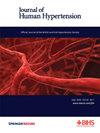体重指数改变了青少年和年轻人对高收缩压的遗传易感性:一项18年纵向研究的结果。
IF 3.4
4区 医学
Q2 PERIPHERAL VASCULAR DISEASE
引用次数: 0
摘要
成人全基因组关联研究(GWAS)已经确定了与收缩压(SBP)相关的单核苷酸多态性(snp),但尚不清楚该发现是否适用于青少年。此外,身体质量指数(BMI)在这些关联中的作用尚未得到充分研究。我们的目的是确定BMI是否会改变年轻人对高收缩压的遗传易感性。样本包括1999年至2000年间从蒙特利尔地区10所高中招募的714名欧洲血统的参与者,进行纵向研究。分别在12岁、15岁、17岁、24岁和30岁时测量收缩压。他们分别在14岁、20岁和25岁时采集了血液和唾液样本。基于成人GWAS结果构建了两个基于证据的遗传风险评分(GRS): GRS22使用了22个snp, GRS182在GRS22的基础上增加了160个snp。使用线性混合模型(包括BMI和GRS*BMI乘积项)估计每个GRS和重复收缩压测量之间的性别特异性关联。GRS182比GRS22解释了更大比例的SBP方差,女性比男性更大比例。随着BMI值在22 ~ 35 kg/m2之间,相关性单调增加。结果表明,BMI改变了青春期至成年期GRS和收缩压水平之间的关系。本文章由计算机程序翻译,如有差异,请以英文原文为准。

Body mass index modifies genetic susceptibility to high systolic blood pressure in adolescents and young adults: results from an 18-year longitudinal study
Genome-wide association studies (GWAS) in adults have identified single nucleotide polymorphisms (SNPs) associated with systolic blood pressure (SBP), but it is unclear whether the findings apply in youth. Further, the role of body mass index (BMI) in these associations is understudied. Our objective was to determine whether BMI modifies genetic susceptibility to high SBP in young people. The sample comprised 714 participants of European ancestry recruited in 1999–2000 from 10 Montreal-area high schools for a longitudinal study. SBP was measured at ages 12, 15, 17, 24, and 30. Blood and saliva samples were collected at ages 14, 20, and 25. Two evidence-based genetic risk scores (GRS) were constructed based on GWAS results in adults: GRS22 used 22 SNPs and GRS182 added 160 additional SNPs to GRS22. Sex-specific associations between each GRS and repeated measures of SBP were estimated using linear mixed models including BMI and a GRS*BMI product term. GRS182 explained a greater proportion of SBP variance than GRS22, and a greater proportion in females than males. The associations increased monotonically with BMI values between 22 kg/m2 and 35 kg/m2. Results indicate that BMI modifies the association between a GRS and SBP levels from adolescence to adulthood.
求助全文
通过发布文献求助,成功后即可免费获取论文全文。
去求助
来源期刊

Journal of Human Hypertension
医学-外周血管病
CiteScore
5.20
自引率
3.70%
发文量
126
审稿时长
6-12 weeks
期刊介绍:
Journal of Human Hypertension is published monthly and is of interest to health care professionals who deal with hypertension (specialists, internists, primary care physicians) and public health workers. We believe that our patients benefit from robust scientific data that are based on well conducted clinical trials. We also believe that basic sciences are the foundations on which we build our knowledge of clinical conditions and their management. Towards this end, although we are primarily a clinical based journal, we also welcome suitable basic sciences studies that promote our understanding of human hypertension.
The journal aims to perform the dual role of increasing knowledge in the field of high blood pressure as well as improving the standard of care of patients. The editors will consider for publication all suitable papers dealing directly or indirectly with clinical aspects of hypertension, including but not limited to epidemiology, pathophysiology, therapeutics and basic sciences involving human subjects or tissues. We also consider papers from all specialties such as ophthalmology, cardiology, nephrology, obstetrics and stroke medicine that deal with the various aspects of hypertension and its complications.
 求助内容:
求助内容: 应助结果提醒方式:
应助结果提醒方式:


